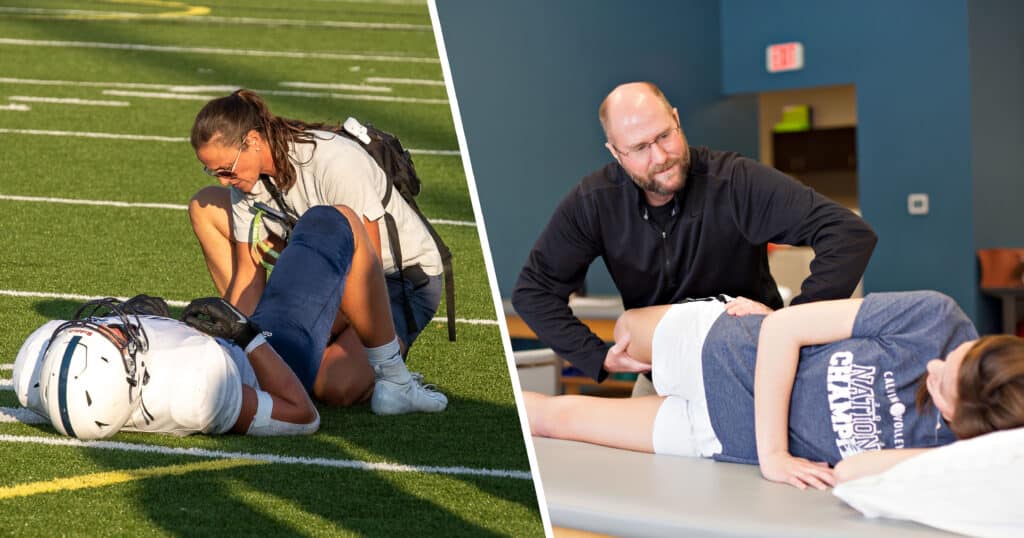Athletic Trainer vs Physical Therapist

Myself and a few other clinicians at Hulst Jepsen Physical Therapy had a unique journey in becoming physical therapists. We all became certified athletic trainers before becoming physical therapists. With this combination, we have a unique perspective on treatment for our patients as a dual credentialed clinician. We all have a passion for sports, caring for the wide variety of athletes, and helping them return to the sport or activity they love. Many may not know what an athletic trainer is, and the career is often confused with being a physical therapist or personal trainer.
What is an athletic trainer?
An athletic trainer is a healthcare professional who works with any type of patient but mostly commonly works with athletes to prevent, diagnose, treat, and rehabilitate acute or chronic injuries and medical conditions. Athletic trainers work alongside doctors, coaches, and healthcare teams to care for their patients. Athletic trainers are often the first medical professionals patients see so they have expertise in emergency and acute care of injuries and medical conditions. Athletic trainers can work in a variety of settings, including sports facilities, schools, job sites, rehabilitation clinics, medical offices, or hospitals. They are commonly the people you see rush on the field after an injury or helping on the sideline of a game, but they have many other roles that you don’t get to see.
What is a physical therapist?
A physical therapist is a healthcare professional who evaluates and treats individuals with injuries or medical conditions that limit their ability to move. They use methods like exercises, manual therapy, and education to help restore function, manage pain, and improve overall mobility and strength. They work with a wide variety of patients and diagnoses. Physical therapists can work in a variety of settings, including outpatient clinics, hospitals, skilled nursing facilities, schools, or patient homes. They can treat orthopedic injuries, chronic pain, post-surgical, sports injuries, and neurological disorders.
How are athletic trainers the same as physical therapists?
They are colleagues in a healthcare professional team and often work together to care for patients. Both professions require a higher education degree with a national certification exam as well as a state license to practice. They both can provide treatment and rehabilitation for all types of patients.
What makes athletic trainers different than physical therapists?
Athletic trainers are trained for emergent and acute injuries at sports events, including first responder emergency care. They are able to administer first aid and deliver faster treatments during a game to help athletes remain on the field and stay in a game. They can also quickly decide whether an athlete should be removed from the game or if it’s necessary to call 911.
How does a certification in athletic training help us as physical therapists?
With a background in healthcare, athletic trainers are more prepared for physical therapy school and clinical experiences. They already have a foundation of healthcare knowledge that we get to expand on in physical therapy school. Athletic trainers have already had experience with caring for and communicating with patients, skills we get to continue to grow in physical therapy school and clinical. With the combination of athletic training and physical therapy, we have a passion for sports and a better understanding of the athletic population’s demands and return to sports criteria.
I wouldn’t be the physical therapist I am today without my certification in athletic training. It allowed me to set up for greater success personally and with my patients. At Hulst Jepsen Physical Therapy, we all care about our patients and want success in helping them return to the activities that they enjoy. Having an athletic training background helps us elevate our care for all patients because athletes can be a wide variety of ages, activities, and skills. Working with sports translates to all repetitive body movements that we do throughout our day even if not a true athlete. As a team, we want our patients to be the healthiest and best athletes they can be – at home and on the field!
For more information about Sports Medicine and Athletic Training at Hulst Jepsen Physical Therapy, contact us at 616-256-8679 or receptionst@hjphysicaltherapy.com.
